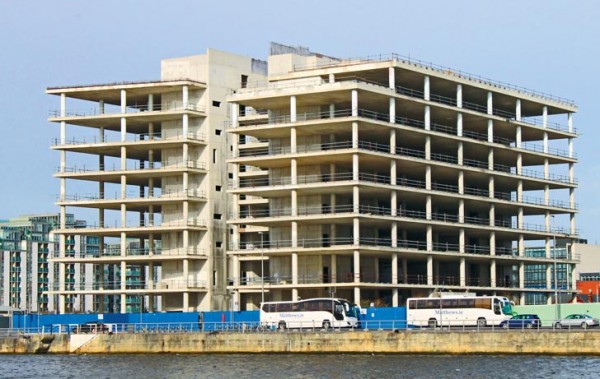
Just a few months ago the Central Bank of Ireland announced a plan for the redevelopment of the former Anglo Irish site on the North Quays.
The plan, which will be viewable at the council’s Wood Quay offices, proposes a gleaming steel structure with box-like windows as its exterior. For a site that stands as a permanent scar within Ireland’s economic psyche, what does its redevelopment say about where we are going?
Anglo, five letters that strike fear into the minds of those of us trying to forget the bad days back in 2008 when the boat rocked and very nearly sank. In the heart of Spencer Dock stands what was supposed to be its crowning jewel, a five-floor concrete carcass of a building left behind by the economic crash.
“To me [the building] is about everything that had gone wrong in Ireland – the culture of crazy bank lending and a lack of regulation in the country,” said Fine Gael Councillor Kieran Binchy. “It does look like it’s post-apocalyptic; it looks like something from Mad Max.”
Before the Central Bank bought the site back in 2012, the area was left desolate; the building became the icon for a broken national economy.
“The current Anglo building is highly symbolic of the difficulties that Ireland has gone through in the last few years,” said Niamh Moore the author of the book Dublin Docklands Reinvented. “It is probably fitting that attention is now being directed to bringing it back to productive use to allow it become a new symbol of Ireland’s emergence from its difficulties.”
As NewsFour reported in 2012, a group called Mahoney Architecture had plans to turn the site into a public park and urban space. The Trees on the Quays Initiative planned to incorporate distinctive hills, trees and terraces into the main building and the surrounding land, creating what NewsFour’s Tracy O’Brien called a “stepped landscape in the shell of the building”. The initiative was later abandoned when the Central Bank purchased the site.
Work on the new Central Bank building doesn’t actually begin until late this year, possibly early next year, with architecture firm Henry J Lyons and partners acting as the main custodians for the project. The group was chosen to design and implement a number of structural and environmental changes to the building, making it totally energy efficient with natural ventilation and the ability to harvest rainwater to operate its internal wastage system.
“It’s a good thing from the point of view that it can’t stand there indefinitely,” said Gerry Fay the Chairman of the Northwall Community Association. “It’s progress and you don’t want to be stopping progress, let’s get it done, let’s move forward.”
By Liam Cahill

